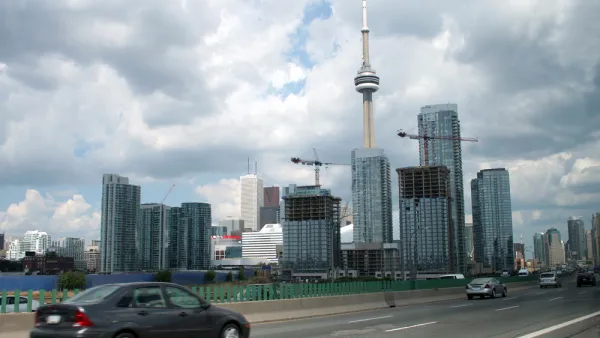As the full extent of the instability of Toronto's elevated Gardiner Expressway, and the city's apparent cover-up of the information, becomes clear, the new chief planner has weighed in on what the priorities should be in addressing the problem.

The signs of the Gardiner's fialing health have been raining down on Toronto's streets for some time. After at least seven incidents of falling-concrete this year, and a recent Toronto Star investigation that showed "the crumbling highway is in a state far worse than city staff previously told the public," the city's new chief planner Jennifer Keesmaat has waded into the debate over the future of Toronto's main commuter artery, reports Robyn Doolittle.
With reports indicating that, "[w]ithout half a billion dollars in emergency repair work to the deck, nearly half of the elevated portions of the Gardiner could be structurally unsafe within a decade," Keesmaat said "she is opposed to spending massive sums on infrastructure focused on 'moving more cars,'” and instead, "believes tax dollars are better spent on improving public transit."
"Keesmaat, who has been in the job less than six months, said she wants to immediately resume an environmental assessment that was quietly shelved after Mayor Rob Ford’s election," notes Doolittle. "That study was supposed to provide a cost-benefit analysis of tearing down versus maintaining the structure."
Writing in Spacing Toronto, Ken Greenberg sees the deterioration of the expressway as an opportunity for the city to engage in a serious discussion about "a more sustainable balance of mobility options."
"At a certain point," he says, "the cost and difficulty of maintaining or in our case entirely rebuilding these structures raises the question of whether it makes sense to keep them. Rather than replacement, the decaying infrastructure can be modified or altered to become one that favours more environmentally sound means of getting around harmonizes with a more productive city form."
FULL STORY: Gardiner Expressway: Chief planner wants to resurrect cost/benefit study

National Parks Layoffs Will Cause Communities to Lose Billions
Thousands of essential park workers were laid off this week, just before the busy spring break season.

Retro-silient?: America’s First “Eco-burb,” The Woodlands Turns 50
A master-planned community north of Houston offers lessons on green infrastructure and resilient design, but falls short of its founder’s lofty affordability and walkability goals.

Delivering for America Plan Will Downgrade Mail Service in at Least 49.5 Percent of Zip Codes
Republican and Democrat lawmakers criticize the plan for its disproportionate negative impact on rural communities.

Test News Post 1
This is a summary

Test News Headline 46
Test for the image on the front page.

Balancing Bombs and Butterflies: How the National Guard Protects a Rare Species
The National Guard at Fort Indiantown Gap uses GIS technology and land management strategies to balance military training with conservation efforts, ensuring the survival of the rare eastern regal fritillary butterfly.
Urban Design for Planners 1: Software Tools
This six-course series explores essential urban design concepts using open source software and equips planners with the tools they need to participate fully in the urban design process.
Planning for Universal Design
Learn the tools for implementing Universal Design in planning regulations.
EMC Planning Group, Inc.
Planetizen
Planetizen
Mpact (formerly Rail~Volution)
Great Falls Development Authority, Inc.
HUDs Office of Policy Development and Research
NYU Wagner Graduate School of Public Service




























